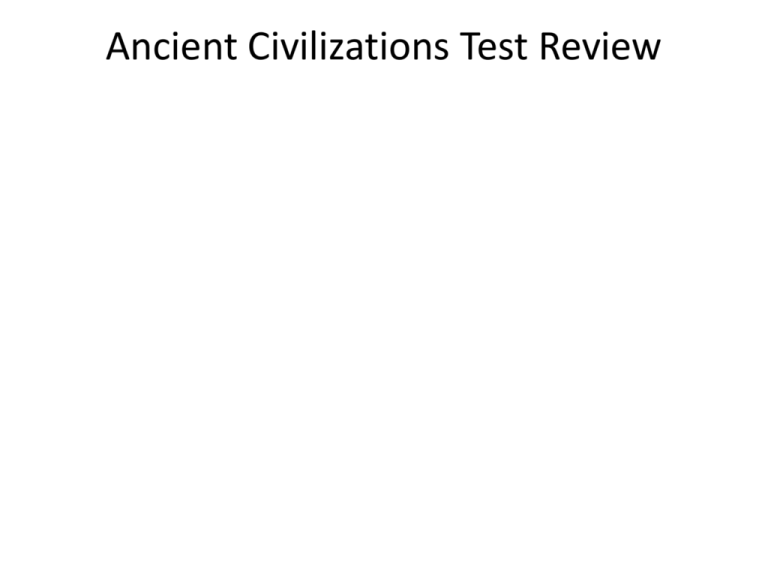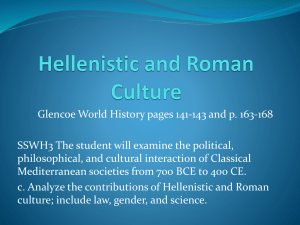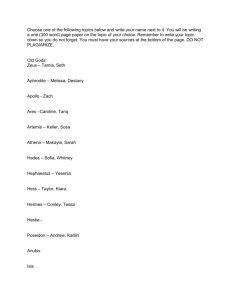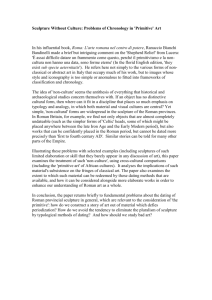AVI1O Ancient Civilizations Test Review
advertisement

Ancient Civilizations Test Review Stand for true. Sit for false. Paleolithic means “old stone age” TRUE • Stand for true • Sit for false • The cave painters of Lascaux and Altamira used metal tools, ground up pigments from the earth, blood, and animal fat to make their paintings. FALSE (make sure every part of the answer is correct. Stone age people did not use metal tools) • Stand for true • Sit for false • The Venus of Willendorf is a Greek statue FALSE • The Venus of Willendorf is a small stone sculpture from the Paleolithic period that was probably a fertility symbol. • Stand for true • Sit for false • Prehistoric cave painters made images of bison and deer in hopes of controlling the spirits of these animals, making them easier to hunt. TRUE • Stand for true • Sit for false • Egyptian artists always signed their work •FALSE • They were not allowed to sign their work, as this would immortalize the artist, not the pharoah, or whoever the artist was painting. • Stand for true • Sit for false • Registers were the layers, or levels on Egyptian stelae, allowing the artists to tell a story, in a sequence of images. TRUE • Stand for true • Sit for false • The Egyptians discovered the use of perspective to make three dimensional space in their art work. FALSE The Egyptians did not understand how to use perspective to create the illusion of 3 dimensional space in a picture Stand for true. Sit for false. • Egyptians made images of themselves because they believed that this would immortalize them, allowing them to exist, with their possessions, in the afterlife. TRUE Stand for true. Sit for false. • Egyptian pharoahs were always buried in the pyramids. • FALSE • Only the pharoahs of the Old Kingdom were buried in pyramids. • Since robbers invariably broke into the pyramids, pharoahs from the Middle and Late kingdoms were buried in temples carved into the cliffs along the Nile River. • Stand for true • Sit for false • The three periods of Greek Vase Painting were called Doric, Ionic and Corinthian FALSE Stand for true. Sit for false. • The three periods of Greek vase painting were • Geometric • Stick Figure • Realism TRUE (make sure you read the questions on the test very carefully) Stand for true. Sit for false. • This vase comes from the geometric period of Greek vase painting. • FALSE • This vase comes from the stick figure period. • (Look at the little stick figures) End of the true/false section. • You may all sit down now Multiple Choice Section Use the cards marked A, B, C and D to indicate the correct answers to the following questions. • The capital of ancient Greece was • A) Rome • B) Athens • C) Lascaux • D) Altamira • B) Athens • Statues from the archaic period of Greek sculpture wore • A) wigs • B) furs • C) archaic smiles • D) silk • C) Archaic smiles • The Second period of Greek sculpture was known as • A) geometric • B) Doric • C) Hellenistic • D) Classical • D) Classical The name of this sculpture is a) Discobolus b) Doryphorus c) The Nike of Samothrace d) The Venus de Milo • B) Doryphorus (the spear bearer) • The stance of the Spear Bearer is known as • A) aphrodite • B) raking • C) contrapposto • D) archaic • Greek sculptures from the Hellenistic period • A) were more dramatic than classical sculptures • B) evoked an emotional response • C) were full of movement • D) all of the above • D) all of the above • This statue comes from which period of Greek sculpture? • A) archaic • B) classical • C) hellenistic • D) Egyptian • C) Hellenistic • It is dramatic, emotional, and full of movement. • The Romans invented two things that made architectural advances possible. They were: • A) arches and concrete • B) steel and bricks • C) post and lintel • D) eggs and toast • D) eggs and toast • Just kidding. • The Romans invented arches and concrete (answer A) Aqueducts A) Were hot pools in the spas of Roman cities B) Carried water into Roman cities from as far as 100 km away C) Flew south every winter D) Were theatres in Roman cities • B) Aqueducts carried water into Roman cities from as far as 100 km away. Everyone stand up. • Step left if the correct answer is on this side. • Step right if the correct answer is on this side. Roman cities were laid out on a • grid • mountain Roman houses were built • With clay • Around interior courtyards Roman busts were • More realistic • More idealistic The hottest pool in a Roman bath complex was the • Tepidarium • Calidarium The Pantheon was built to honour • Athena, goddess of wisdom • The 7 Roman planetary gods Don’t get the Parthenon mixed up with the Pantheon The Parthenon was built by the Greeks, in Athens. The Pantheon was built by the Romans, in Rome Mosaics are • Patterns made with small tiles and stones, often seen on the floors of Roman homes • Tombstones decorated with the wax portraits of dead Romans The Circus Maximus • was performed with elephants and dancing bears • Was a circular course for Roman chariot races The large, central section of a basilica was • the nave • The ambulatory The coliseum in Rome could hold • 100,000 spectators • 50,000 spectators








